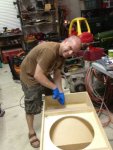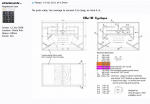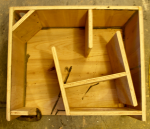I was cleaning out a hard drive Tuesday night and came across a project from 2012. At the time I was playing around with horn flares that were augmented with a resonator of sorts near the throat. The simulations looked interesting, so with the help of Loren Jones' excellent carpentry, we took the fourth iteration of that design and made sawdust.
The result was a single 18" in a 22.5" x 45" package, built around the B&C 18SW115. At the time, the 18SW115 was the best woofer widely available to the DIY audience. Today I would use the (upcoming) B&C 18DS115-4 instead. Sadly, we never had the opportunity to properly measure that enclosure in anger, under high power operation. Life is very different for both myself and Dr. Jones today, but I am hopeful that we can still get this project properly tested. Stay tuned on that.
Today is a musically impactful day for me, with unexpected suicide of Chris Cornell. My grandfather ran a company designing and installing paging equipment in Detroit's heyday. As a teenager I was already marginally competent with audio gear and building speakers. It was my discovery of Soundgarden's Superunknown, first on the radio in the high school cafeteria, and later as full record, was instrumental in expanding interests beyond electronics to the craft of micing and mixing music. I never had the talent or patience for the studio world, but I have more than fifteen years of moonlighting in live sound, including a five year stint as the technical columnist for FOH magazine. Superunknown had a tangible role in that for me, and it feels an appropriate date to release an old science experiment to the community.
The Google Drive link below has the Akabak files and Sketchup drawings for the version that we built. There were never formal CAD for the ASSY, but there's an outside possibility those could be generated at a later date:
https://drive.google.com/drive/folders/0BwZr3b_1ro5URHR3M2JWZGdCOFE?usp=sharing

The result was a single 18" in a 22.5" x 45" package, built around the B&C 18SW115. At the time, the 18SW115 was the best woofer widely available to the DIY audience. Today I would use the (upcoming) B&C 18DS115-4 instead. Sadly, we never had the opportunity to properly measure that enclosure in anger, under high power operation. Life is very different for both myself and Dr. Jones today, but I am hopeful that we can still get this project properly tested. Stay tuned on that.
Today is a musically impactful day for me, with unexpected suicide of Chris Cornell. My grandfather ran a company designing and installing paging equipment in Detroit's heyday. As a teenager I was already marginally competent with audio gear and building speakers. It was my discovery of Soundgarden's Superunknown, first on the radio in the high school cafeteria, and later as full record, was instrumental in expanding interests beyond electronics to the craft of micing and mixing music. I never had the talent or patience for the studio world, but I have more than fifteen years of moonlighting in live sound, including a five year stint as the technical columnist for FOH magazine. Superunknown had a tangible role in that for me, and it feels an appropriate date to release an old science experiment to the community.
The Google Drive link below has the Akabak files and Sketchup drawings for the version that we built. There were never formal CAD for the ASSY, but there's an outside possibility those could be generated at a later date:
https://drive.google.com/drive/folders/0BwZr3b_1ro5URHR3M2JWZGdCOFE?usp=sharing






